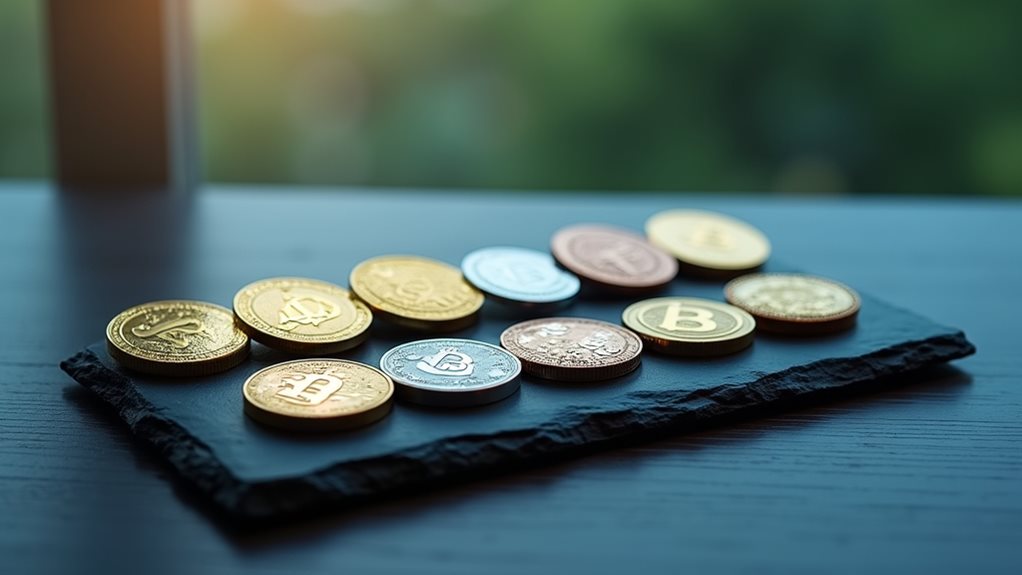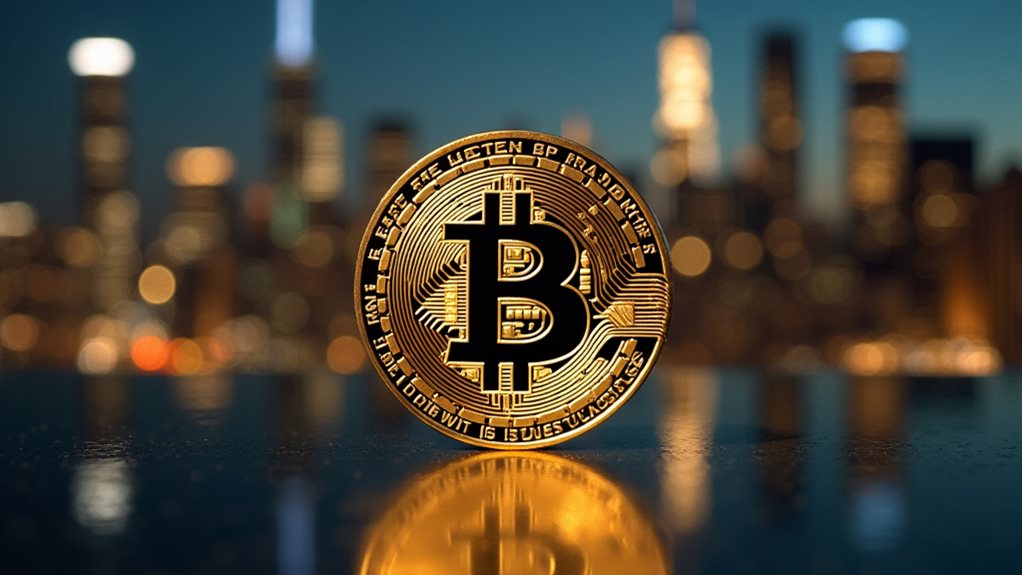Looking to start your crypto expedition? Bitcoin remains the gold standard with its 21 million coin cap, while Ethereum powers the entire DeFi ecosystem. Solana offers lightning-fast transactions, and XRP focuses on banking solutions. Don’t overlook Cardano’s scientific approach or Binance Coin’s utility within its massive exchange. Polkadot connects blockchains, Avalanche provides eco-friendly alternatives, and Stellar handles cross-border payments dirt cheap. The crypto world awaits your exploration.
Bitcoin (BTC): The Digital Gold Standard
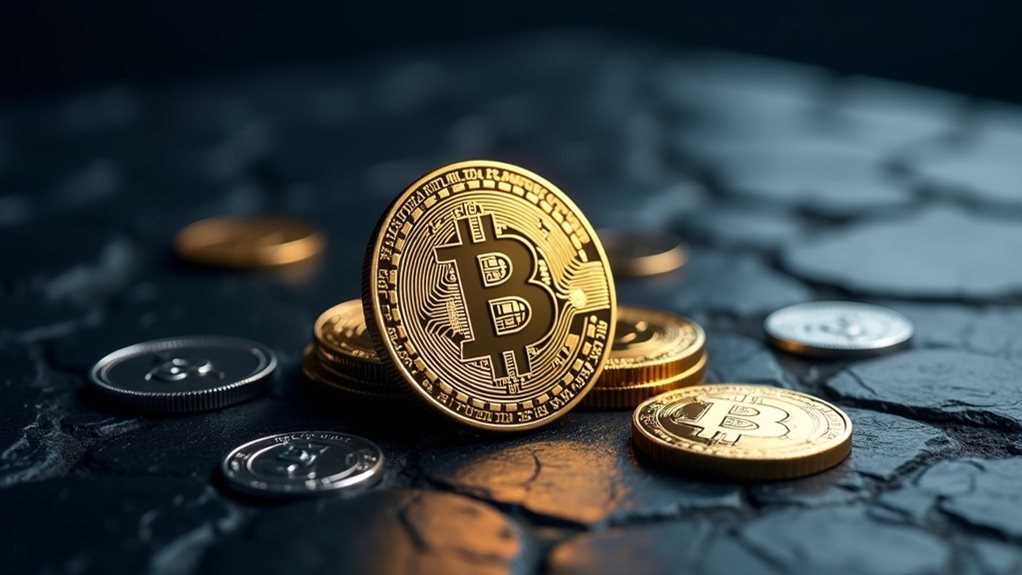
Bitcoin isn’t just digital money—it’s digital gold. Unlike traditional currencies that governments print endlessly, Bitcoin has a strict cap of 21 million coins. Ever. Period. This scarcity mechanism is why many see it as serious inflation protection during economic uncertainty.
Sure, Bitcoin volatility can make your stomach churn—wild price swings aren’t for the faint-hearted. But its decentralized finance structure means no government can freeze or seize your assets. Pretty powerful stuff. Despite reaching record-breaking liquidations in 2024, Bitcoin continues to attract investors.
After April 2024’s halving event, new Bitcoin production slowed again, making existing coins potentially more valuable. The mining reward decreased from 6.25 to 3.125 BTC per block, further emphasizing Bitcoin’s programmed scarcity over time. The investment potential attracts both everyday folks and big institutions.
With global accessibility allowing transfers without middlemen, this digital currency continues reshaping market trends despite the rollercoaster ride. Freedom has a price, right? Bitcoin offers significant advantages over physical gold with faster and cheaper transactions that don’t require the logistical complexity of shipping physical assets.
Ethereum (ETH): Smart Contracts and DeFi Powerhouse
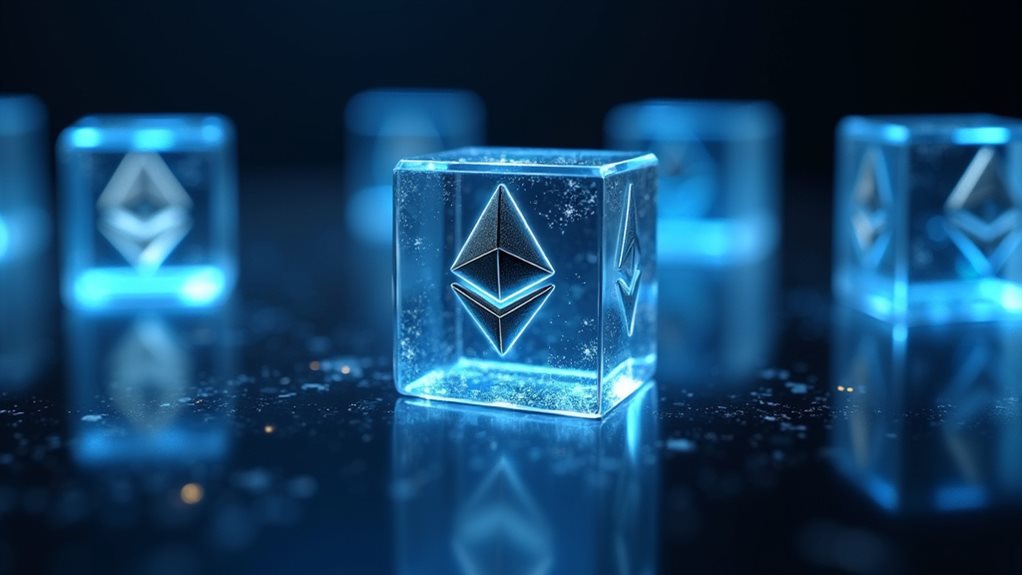
While Bitcoin gets all the spotlight, Ethereum takes blockchain technology to a whole new level.
It’s not merely digital money—it’s programmable money. Ethereum’s smart contracts are self-executing code that automate complex financial deals without middlemen. No banks needed. Imagine that.
These smart contracts power the entire DeFi ecosystem, where you can lend, borrow, and trade 24/7. The transparency of these systems creates an immutable audit trail that builds trust among users and protects against fraud.
Smart contracts drive DeFi’s 24/7 financial universe—lend, borrow, and trade without gatekeepers or closing bells.
Platforms like Aave and Uniswap? All running on Ethereum. Smart contract security remains vital—one code bug could cost millions. Most DeFi developers use Solidity language to create these autonomous financial agents on the blockchain.
The numbers don’t lie. With over $53 billion locked in DeFi and projections reaching $200 billion by 2025, Ethereum’s impact is massive. Users can earn passive income through staking and yield farming opportunities.
Institutional money is watching too.
Decentralized governance means users control the protocols.
Your money, your rules. Revolutionary stuff.
Solana (SOL): Speed and Scalability for Everyday Use

Unlike traditional blockchains bogged down by congestion, Solana blazes through transactions at mind-boggling speeds.
We’re talking 65,000 transactions per second. Ethereum? A measly 15 TPS. Pathetic.
Solana’s transaction speed isn’t just impressive—it’s revolutionary. Transactions finalize in under 150 milliseconds. That’s faster than you can say “gas fees.”
Network scalability gets even better with Firedancer, aiming for a million TPS. No joke. Developers love it because transactions cost pennies, literally below one cent.
No wonder Solana’s become home to NFT marketplaces, gaming, and DeFi. The ecosystem’s booming, with $13 billion locked in its protocols.
Real businesses use Solana Pay for actual purchases. The recent Alpenglow upgrade has further reduced block finality times from 12.8 seconds to just 100-150 milliseconds.
Fast, cheap, practical. That’s Solana.
Analysts project Solana could capture 22% market share of the smart contract sector by 2025, solidifying its position as a leading Ethereum alternative.
XRP: Banking-Focused Payment Solutions

Traditional banking’s cross-border payments are a nightmare—slow, expensive, outdated. Enter XRP, already adopted by major banks like Santander and American Express for a reason. It just works.
RippleNet integration lets financial institutions join a network that’s revolutionizing global payments through:
- Instant settlements – transactions complete in seconds, not days
- Minimal fees – forget those ridiculous international transfer charges
- XRP liquidity solutions – eliminates pre-funded accounts in foreign countries
The tech behind it? Pretty impressive. XRP uses Validators to confirm transactions while xRapid provides on-demand liquidity by converting currencies through XRP. PNC Bank has joined this technological revolution, expanding its reach in the global market against traditional payment systems.
Despite ongoing legal developments, XRP continues to see increased institutional adoption and market activity. It’s basically SWIFT on steroids. Standard Chartered and SBI Holdings aren’t embracing this tech for fun—they’re doing it because traditional systems can’t compete with XRP’s speed and efficiency. The XRP ledger requires less electricity consumption compared to Bitcoin mining, making it a more environmentally sustainable option.
Cardano (ADA): Scientific Approach to Blockchain

If you’ve ever thought blockchain was just about throwing tech at a wall and seeing what sticks, Cardano will change your mind. This cryptocurrency is built on scientific validation and research-driven design that would make your college professor proud.
Unlike its energy-guzzling predecessors, Cardano uses Ouroboros—a peer-reviewed proof-of-stake protocol that’s actually energy efficient. No planet-killing mining rigs here!
Ouroboros: academic rigor meets eco-friendly blockchain. Finally, crypto that won’t melt the ice caps.
Its development follows structured phases (cute names like “Byron” and “Voltaire”), systematically addressing smart contract security, network decentralization, and scalability innovations. The upcoming Hydra layer 2 solution aims to provide virtually unlimited scalability for the network.
The platform’s formal methods and Haskell programming guarantee code correctness that most cryptos can only dream about.
With decentralized governance coming in its “Voltaire” phase, you’ll eventually vote on changes. Revolutionary? Maybe. Built on actual science? Definitely.
Cardano’s blockchain architecture uniquely splits into two separate layers that handle settlement and computational tasks independently, enhancing both security and flexibility.
Stablecoins: Your Low-Risk Entry Point
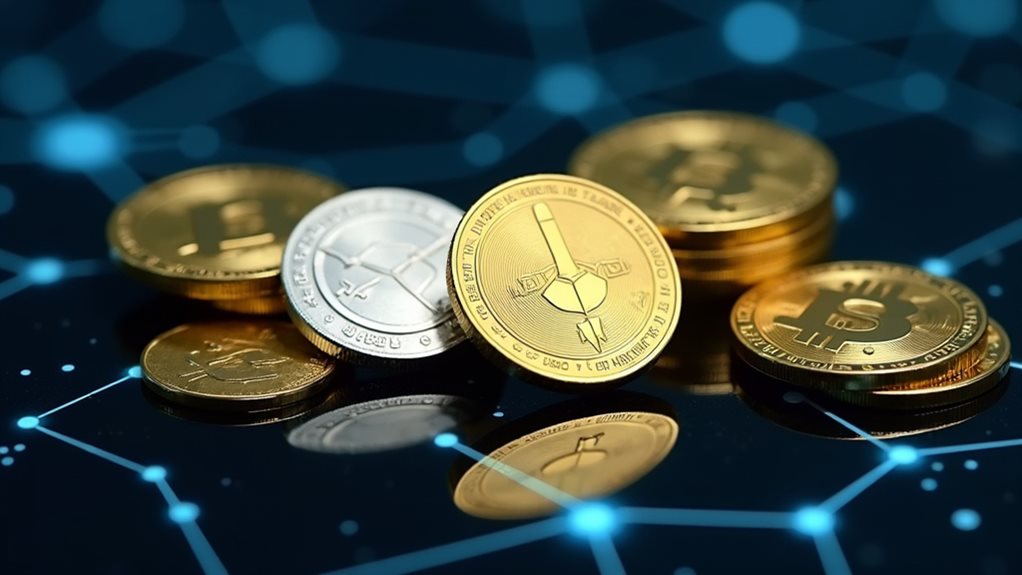
While Cardano attracts the science-minded crypto enthusiasts, not everyone wants to ride the cryptocurrency rollercoaster.
Enter stablecoins – your safe harbor in the crypto storm. With a whopping $300 billion market cap and growing fast, these digital assets offer stability when Bitcoin’s doing its wild dance. The total stablecoin market reached approximately 246 billion dollars in May 2025, showing continued growth in this segment. Ethereum continues to be the primary platform for stablecoin issuance with $171 billion in stablecoins. Consumer protection measures are increasingly emphasized in the evolving crypto space.
Stablecoin advantages are pretty straightforward:
- Cross-border payments without the bank fees and delays (goodbye, three-day transfers!)
- DeFi participation without losing sleep over price crashes
- Portfolio protection when everything else is tanking
Tether dominates with 59% market share, followed by USDC at 25%. Not too shabby.
But watch out – regulatory challenges loom large. Governments aren’t exactly thrilled about private companies printing dollar equivalents. Transparency issues? You bet.
Still beats watching your investment evaporate overnight.
Binance Coin (BNB): Utility Token With Exchange Benefits

Powerhouse. That’s BNB in summary. Surging 243% between January 2024 and September 2025, this token’s not messing around. With a market cap of $53.6 billion (up from $43.2 billion last year), it’s serious business. While spot trading features remain available for U.S. users on Binance.US, the global platform offers more extensive opportunities.
BNB dominates crypto markets with explosive growth and a $53.6 billion market cap. This powerhouse isn’t playing games.
A BNB tokenomics analysis reveals what makes it special: it’s deflationary. They burn tokens regularly. Less supply, potentially more value. Simple math.
In the Binance ecosystem, benefits stack up fast. Pay transaction fees. Execute smart contracts. Farm yields. Buy NFTs. Trade cheaper with VIP status. The January 2025 burn removed 2.3 million BNB from circulation, valued at $797 million. Over a million merchant payments monthly worldwide—not too shabby. BNB recently achieved the remarkable milestone of reaching $1,000 in just 3,000 days, making it the third fastest cryptocurrency to hit this price point.
Price predictions? Potentially $1,239 by year-end. Volatile? Sure. But with trading volumes up 50% and record wallet activity, BNB’s evolved beyond just an exchange token.
Polkadot (DOT): Connecting Blockchain Networks

Born from the mind of Ethereum co-founder Gavin Wood, Polkadot has revolutionized how blockchains talk to each other since its 2020 launch.
It’s not merely another crypto—it’s a Layer-0 platform that lets different blockchains communicate. Finally! The network employs a proof-of-stake mechanism that provides an eco-friendly alternative to energy-intensive blockchains.
What makes DOT worth your attention?
- Parachain auctions determine which projects join the ecosystem—no freeloaders here. Projects must earn their place through community support.
- Shared security means smaller chains don’t need their own validators. They piggyback on the main Relay Chain’s security. Pretty clever.
- The upcoming Polkadot 2.0 upgrade (October 2025) could seriously boost performance—just as its recent 10x throughput increase did.
DOT’s price has been on a rollercoaster—from $55 highs to notable drops. The community recently approved a hard cap of 2.1Bn DOT, enhancing its scarcity and potential value.
That’s crypto for you. Unpredictable, exciting, terrifying.
Avalanche (AVAX): Fast Finality and Eco-Friendly Design

Speed demon AVAX entered the crypto scene with a simple promise: transactions that finalize in seconds, not minutes. Yeah, you read that right. Seconds.
Blink and you missed it – that’s AVAX finalizing your transaction while other chains are still warming up.
What makes it tick? The Avalanche consensus protocol uses random sampling between nodes rather than forcing everyone to talk to each other. Smart.
Their three-chain setup divides labor efficiently—one for assets, one for validators, and one for smart contracts. Smart contract audits are routinely performed to ensure maximum security for users.
You’ll appreciate AVAX’s eco-friendly staking approach. No massive energy bills here. Validators simply stake tokens instead of burning electricity like Bitcoin miners. Mother Earth says thanks.
Subnet scalability is AVAX’s secret weapon. Each subnet handles specialized tasks without clogging the main network. Throughput for days.
Developer incentives are robust, with EVM compatibility making it easy to port existing Ethereum projects. Build once, deploy everywhere. Currently sitting at a $28.33 price point, AVAX ranks 14th in the crypto ecosystem by market capitalization.
Analysts project AVAX could see significant growth by 2026, potentially reaching the $100 mark for patient investors.
Stellar (XLM): Affordable Cross-Border Transactions

While Bitcoin and Ethereum grab headlines, Stellar (XLM) quietly revolutionizes how money moves across borders.
Built for financial inclusion, Stellar lets you send money globally in seconds—not days—with fees so low they’re practically invisible (0.000002 XLM per transaction). Seriously, that’s cheaper than the electricity used to think about traditional bank fees. Smart contracts on Stellar’s Soroban platform provide additional programmable finance features beyond basic transfers.
The Stellar anchor network connects real-world financial institutions to crypto, making cross border efficiency actually achievable for everyday users. You don’t need a PhD in blockchain to use it. The network completely eliminates intermediary banks typically required in traditional SWIFT transactions.
- Settles transactions in 5-7 seconds flat
- Powers global remittances 24/7/365 without banking holidays
- Facilitates micropayments that would be impossible with traditional systems
Cryptocurrency education isn’t complete without understanding Stellar’s practical application. It’s not only tech—it’s useful tech.
Frequently Asked Questions
How Do I Report Cryptocurrency Gains on My Taxes?
You’ll report cryptocurrency gains on Schedule D and Form 8949 with your tax return. Don’t forget to include cryptocurrency losses too, as proper tax reporting requires documenting all transactions, even unprofitable ones.
What Hardware Wallets Are Best for Securing Multiple Cryptocurrencies?
OneKey Pro, Ledger Nano X, and Trezor Model T are your best multi-currency wallets. They offer robust hardware wallet features like secure chips, support thousands of cryptocurrencies, and provide various connectivity options for convenient access.
Can I Mine These Cryptocurrencies at Home?
You can’t mine most popular cryptocurrencies at home profitably. Bitcoin requires expensive ASIC hardware, Ethereum uses staking now, and most newer coins aren’t mineable. Home mining profitability depends heavily on electricity costs and hardware investment.
How Do Crypto Airdrops Work and Are They Worth Claiming?
Airdrops work by projects sending free tokens to eligible wallets. They’re worth claiming for potential value, but be cautious of scams. The claiming process varies, with airdrop benefits including free tokens and community participation.
What Happens to My Crypto if an Exchange Goes Bankrupt?
Your crypto becomes frozen as part of the bankruptcy proceedings. You’ll be classified as an unsecured creditor, putting you last in line for asset recovery. Exchange security failures often mean you’ll recover only a fraction, if anything.
